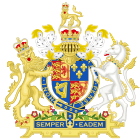Treason Act 1708 facts for kids
| Act of Parliament | |

|
|
| Long title | An Act for improving the Union of the Two Kingdoms. |
|---|---|
| Citation | 7 Ann. c. 21 |
| Dates | |
| Royal assent | 21 April 1709 |
| Commencement | 1 July 1709 |
| Other legislation | |
| Amended by | |
|
Status: Amended
|
|
| Revised text of statute as amended | |
The Treason Act 1708 was a law passed by the Parliament of Great Britain. It was created to make the laws about high treason the same in both England and Scotland. This happened after England and Scotland joined together to form Great Britain in 1707.
This Act is still partly in use in Great Britain today.
Contents
What the Act Changed About Treason
Before this Act, the crime of treason in Scotland was different from England. In Scotland, things like "theft by landowners" or "murder under trust" were considered treason.
The Treason Act 1708 changed this. It got rid of these old Scottish treason definitions. Instead, it made the English definition of high treason apply to Scotland too. The Act also brought the crime of misprision of treason (knowing about treason but not reporting it) to Scotland.
New Treason Crimes
The Act also created some new treason crimes. It became treason:
- To fake the Great Seal of Scotland or other Scottish seals anywhere in Great Britain.
- To kill the Lords of Session or Lords of Justiciary while they were working as judges in Scotland.
These new crimes were similar to existing treason laws in England. For example, in England, it was already treason to kill judges or to fake the English seal.
Since 1708, treason law in Scotland has mostly stayed the same as in England. However, faking the Seal of Scotland is still treason in Scottish law, even though it's not in English law anymore.
When the Scottish Parliament was set up in 1998, treason and misprision of treason were made "reserved matters." This means the Scottish Parliament cannot make laws about them; only the UK Parliament can.
How Treason Cases Were Handled
Section III of the Act said that Scottish courts had to use English rules for trying treason cases. This included how trials were run and what evidence was allowed. However, this rule was removed in 1945.
Parts of the Act Still in Use
The Treason Act 1708 originally had eleven sections, which were later renumbered to fourteen. Four of these sections are still in force today:
- Section 1 made the laws for high treason and misprision of treason in Scotland the same as in England.
- Section 5 made the punishments for high treason and misprision of treason in Scotland the same as in England.
- Section 11 makes it treason to kill certain Scottish judges.
- Section 12 makes it treason to fake "Her Majesty's Seals" that were meant to be used in Scotland after the Union. This includes the Great Seal of Scotland.
See also
- High treason in the United Kingdom
- Treason Act 1743
- Treason Act

